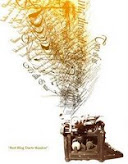Supplies Needed:
Paper
Colored Pencils
Black Crayon
Scissors
Toothpick
 This project can get a little messy so protect your work space with newspaper.
This project can get a little messy so protect your work space with newspaper.Begin by choosing colored pencils. I picked reds, yellows, oranges, and browns because they reminded me of the color of the clay the Greeks used for their vases. Cover your sheet of paper with color. Mix it up. Color large patches of yellow and small patches of brown, circles of orange and triangles of red. Go nuts.
 When your page is completely covered, color over the whole thing with a black crayon. You’ll need to press hard and color in several directions to cover the colored pencil.
When your page is completely covered, color over the whole thing with a black crayon. You’ll need to press hard and color in several directions to cover the colored pencil. Now draw a vase on the back of your page. I folded my paper in half so the vase would be symmetrical. When you’re happy with the vase, cut it out.
Now draw a vase on the back of your page. I folded my paper in half so the vase would be symmetrical. When you’re happy with the vase, cut it out.And now comes the fun part. With a toothpick, scratch patterns and pictures onto your vase. The toothpick will scratch off the crayon and let the colors show through. My vase is shown below. Though not something you would see on an Ancient Greek vase, I drew two people dancing. You can draw anything you want on your vase, including made-up creatures. Be creative.

Return to main page.




 During the Archaic Period, Greek art was influenced by art from other areas of the world. This is because the Greeks were trading goods with neighboring areas. They were also setting up colonies to their east and west. Contact with other cultures allowed Greeks to learn to cut gemstones for jewelry, work with metals, and carve ivory.
During the Archaic Period, Greek art was influenced by art from other areas of the world. This is because the Greeks were trading goods with neighboring areas. They were also setting up colonies to their east and west. Contact with other cultures allowed Greeks to learn to cut gemstones for jewelry, work with metals, and carve ivory.
 Still, though, the Greeks continued to make sculptures and decorated vases. As I said earlier, the images became more realistic. Look at the decoration on the vases above. Big difference from Geometric Period vases, huh?
Still, though, the Greeks continued to make sculptures and decorated vases. As I said earlier, the images became more realistic. Look at the decoration on the vases above. Big difference from Geometric Period vases, huh? 
 During this time, the Greeks began sculpting nude standing male figures (called kouros) and standing female figures with loose cloth draped over them (called kore). You have probably seen statues like the ones shown above.
During this time, the Greeks began sculpting nude standing male figures (called kouros) and standing female figures with loose cloth draped over them (called kore). You have probably seen statues like the ones shown above. Many of these vases were used as headstones in cemeteries.
Many of these vases were used as headstones in cemeteries. Above is a sculpture created during the Geometric Period. Like most sculptures from the period, it is bronze. The most important parts of the horse are the largest (such as the nose) and the least important are smallest (like the torso).
Above is a sculpture created during the Geometric Period. Like most sculptures from the period, it is bronze. The most important parts of the horse are the largest (such as the nose) and the least important are smallest (like the torso). Choose magazine pages with a lot of blue or orange on them. If you don’t have any old magazines, use construction paper instead. Make sure to get permission before you cut any magazines. Cut thin, triangular strips of magazine or construction paper. I used some aluminum foil, too. I like the way the metal shines.
Choose magazine pages with a lot of blue or orange on them. If you don’t have any old magazines, use construction paper instead. Make sure to get permission before you cut any magazines. Cut thin, triangular strips of magazine or construction paper. I used some aluminum foil, too. I like the way the metal shines. If you want your beads to last, brush them with a thin coat of Mod Podge. This will also give your beads a nice shine. Allow your beads to dry.
If you want your beads to last, brush them with a thin coat of Mod Podge. This will also give your beads a nice shine. Allow your beads to dry. Enjoy your ancient Egyptian jewelry!
Enjoy your ancient Egyptian jewelry! Finally, Baroque painters often painted scenes that took place in bright light against dark backgrounds. This is especially noticeable in
Finally, Baroque painters often painted scenes that took place in bright light against dark backgrounds. This is especially noticeable in  The Baroque period ended in the late 1700s.
The Baroque period ended in the late 1700s. Like most Spanish painters of the time, Cotan painted many religious paintings. Religious paintings make up the bulk of his work. Critics agree, though, that his religious paintings are not special. His bodegones, however, were unlike anything that had been painted before and unlike anything else being created at the time.
Like most Spanish painters of the time, Cotan painted many religious paintings. Religious paintings make up the bulk of his work. Critics agree, though, that his religious paintings are not special. His bodegones, however, were unlike anything that had been painted before and unlike anything else being created at the time. In his bodegones, Cotan painted fruits and vegetables against black backgrounds. The food was always very well lighted which allowed Cotan to paint every detail. This helped the fruits and vegetables look real. You’ll notice that some of the food is hanging on strings. This is because people used to hang their produce so it wouldn’t go bad as quickly.
In his bodegones, Cotan painted fruits and vegetables against black backgrounds. The food was always very well lighted which allowed Cotan to paint every detail. This helped the fruits and vegetables look real. You’ll notice that some of the food is hanging on strings. This is because people used to hang their produce so it wouldn’t go bad as quickly. I did not show you any examples of bodegones last week but
I did not show you any examples of bodegones last week but  The painter I’ll tell you about tomorrow is known for his realistic bodegones. His name was Juan Sanchez Cotan and he painted Quince, Cabbage, Melon and Cucumber, shown below.
The painter I’ll tell you about tomorrow is known for his realistic bodegones. His name was Juan Sanchez Cotan and he painted Quince, Cabbage, Melon and Cucumber, shown below.





 When Velazquez was nineteen, he married Pacheco’s daughter, they moved into a house together, and Velazquez opened his own studio. After eight years of study, he was now a master painter.
When Velazquez was nineteen, he married Pacheco’s daughter, they moved into a house together, and Velazquez opened his own studio. After eight years of study, he was now a master painter. Velazquez enjoyed his position as “Painter to the King” but he longed for more freedom. He was able to take a trip to Italy to study the work of the Italian masters but he was rushed back to Spain when a prince was born.
Velazquez enjoyed his position as “Painter to the King” but he longed for more freedom. He was able to take a trip to Italy to study the work of the Italian masters but he was rushed back to Spain when a prince was born. Velazquez loved his time away from the palace. He created many paintings and he loved the freedom of choosing his own subjects. While was in Rome, he even painted a portrait of the Pope (above).
Velazquez loved his time away from the palace. He created many paintings and he loved the freedom of choosing his own subjects. While was in Rome, he even painted a portrait of the Pope (above).

 In his early paintings, Ribera used a strong contrast between light and dark to create murky looking paintings. The painting above, Jerome Hears the Trumpet, is one example. Around 1630, Ribera moved away from this. He began to create paintings that seemed to glow with dim light. An example of this is Saint Francis of Assisi, shown below.
In his early paintings, Ribera used a strong contrast between light and dark to create murky looking paintings. The painting above, Jerome Hears the Trumpet, is one example. Around 1630, Ribera moved away from this. He began to create paintings that seemed to glow with dim light. An example of this is Saint Francis of Assisi, shown below. Check back tomorrow for another Spanish painter.
Check back tomorrow for another Spanish painter.
 Calatrava began his career designing bridges and train stations (like the one shown above). He is currently working on a design for a station at the former site of the World Trade Center. The station will remind viewers of a hand releasing a bird.
Calatrava began his career designing bridges and train stations (like the one shown above). He is currently working on a design for a station at the former site of the World Trade Center. The station will remind viewers of a hand releasing a bird. He has designed many modern-looking buildings that have been constructed throughout the world. I really love the Turning Torso in Malmo, Sweden (shown above). If you are from the Milwaukee area you will certainly have see the Milwaukee Art Museum (below).
He has designed many modern-looking buildings that have been constructed throughout the world. I really love the Turning Torso in Malmo, Sweden (shown above). If you are from the Milwaukee area you will certainly have see the Milwaukee Art Museum (below). In Valencia, Spain you will find the City of Arts and Sciences. The city includes five massive and gorgeous buildings designed by Calatrava. The
In Valencia, Spain you will find the City of Arts and Sciences. The city includes five massive and gorgeous buildings designed by Calatrava. The  One of Gaudi’s buildings,
One of Gaudi’s buildings,  One example is the Parque Guell (sounds like: par-kay gwel) by Antonio Gaudi (shown above). Below is a second example, also by Gaudi. It is the Casa Batllo.
One example is the Parque Guell (sounds like: par-kay gwel) by Antonio Gaudi (shown above). Below is a second example, also by Gaudi. It is the Casa Batllo. They remind me of cartoon castles or bakery cakes. Quite different from the
They remind me of cartoon castles or bakery cakes. Quite different from the 




